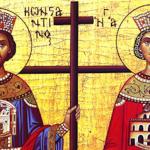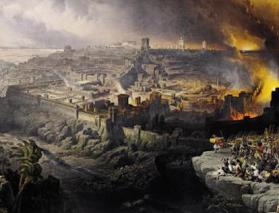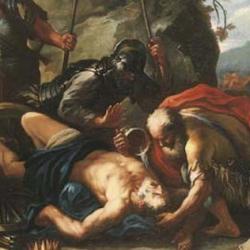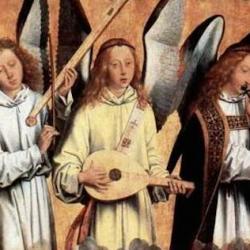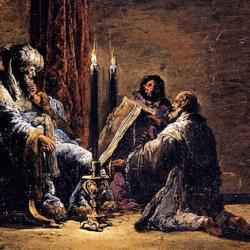Ezra begins where 2 Chronicles ends, with the decree of Cyrus. Some scholars have argued that the repetition indicates that the books were once united. It’s said that the doubling is an ancient literary device to knot together two sections of a text.
Whether that is the case or not, the links between Chronicles and Ezra go beyond the repetition of Cyrus’s decree. In the first volume of his Anchor Bible Commentary on 1 Chronicles 1-9 (77-80), Gary Knoppers sums up the parallels. The bulk of this post summarizes these pages from Knoppers.
Jeremiah is a dominant figure at the end of Chronicles, crucial to the Chronicler’s explanation for the fall of Judah. Zedekiah refuses to listen to Jeremiah (2 Chronicles 36:12) and the exile falls as a fulfillment of Jeremiah’s prophecies (2 Chronicles 36:21). If we look further back in 2 Chronicles, Jeremiah composes and chants a dirge for the death of Josiah (2 Chronicles 35:25).
Jeremiah also prophesied the return (2 Chronicles 36:22) and that prophecy reappears in Ezra 1:1, where the author again states that Cyrus decreed the return in fulfillment of the word of Yahweh by the mouth of Jeremiah.
Temple furniture and vessels link the two passages together as well. In 2 Chronicles 36:7, 10, 18-19), Nebuchadnezzar is taking pieces of the temple into Babylon. Ezra 1:7-11 reverses the process, describing the return of the temple along with the return of the exiles themselves.
The process of constructing the second temple tracks with David’s and Solomon’s work in constructing the first temple:
1.David sets up an altar (1 Chronicles 21) on what becomes the temple site (2 Chronicles 3:1). In Ezra, the altar is raised before the temple is built (Ezra 3:3).
2. Solomon completed the temple in the seventh month, at the time of the Feast of Booths (2 Chronicles 7). The returned exiles celebrate the Feast of Booths when they re-establish the altar (Ezra 3:3-6).
3. David gives and encourages freewill offerings for the temple (1 Chronicles 29), and Ezra also stresses the generosity of the people in contributing to the rebuilding (Ezra 3:5).
4. Solomon makes a deal with Huram of Tyre: He gives food in exchange for wood (2 Chronicles 2). Tyre and Sidon also supply wood for the second temple, in exchange for food (Ezra 3:7).
5. David organizes the Levites and priests in preparation for Solomon’s temple (1 Chronicles 23-25), and Zerubbabel and Joshua re-organize the Levites (Ezra 3:8).
6. Solomon began to build in the second month (2 Chronicles 3:2), and the restoration community lays the foundation in the same month (Ezra 3:8-10).
7. Music plays a major role in David’s installation of the ark in Jerusalem (1 Chronicles 15-16) and Solomon’s temple (2 Chronicles 5:11-14; 7:6). The singers are back to sing and play during the construction of the second temple. As Knoppers points out (79), the Levites are still singing of Yahweh’s eternal hesed (Ezra 3:11; cf. 1 Chronicles 16:34; 2 Chronicles 5:11-14; 7:6-7).
Knoppers sums up the evidence: “In describing the events of the return – the fulfillment of Jeremiah’s prophecy, the reestablishment of the Jerusalem altar, the rites associated with this altar, the preparations for rebuilding the Temple, and the conduct of the officiants – the editor of Ezra 1-3 makes a series of studied references to earlier precedent” (79-80).
Knoppers doesn’t think this constitutes a knock-down argument for common authorship or for a unified text, and neither do I. But it does show that the writer of Ezra considers the second temple a replication of the first, the reconstruction an improvization on the construction.
Beyond Knoppers, we get the full weight of these parallels if we italicize the major discontinuity between the two texts:There is no David or Solomon. To be sure, Zerubbabel is a descendant of David, but he doesn’t play anything like the dominant role that David or Solomon do in 1-2 Chronicles.
Who takes the place of David-Solomon? In one sense, the Persian emperor Cyrus stands in the place of David/Solomon. He authorizes the building (Ezra 1:1-4; 5:13-14, 17), supplies the temple implements (1:7-8), gives permission to the Jews to deal with Tyre and Sidon (3:7). When the people of the land oppose the project, the Jews appeal to the Persian emperor by citing the decree of Cyrus (Ezra 6:1-3).
This is one of the chief political features of the “new covenant” in the post-exilic situation: Gentile rulers take up the Davidic task.
But there’s another answer to the question of who replaces David/Solomon: The people. No king orders a census in Ezra 2, yet a census is taken. There are priests (2:36-39), Levites (2:40-42) and temple servants (2:43-54) on the list, but there’s no David assigning them their task.
Cyrus doesn’t summon the qahal to dedicate the altar, and neither do Joshua or Zerubabbal. The latter preside once the people gather, but the gathering is spontaneous: “the people gathered together as one man to Jerusalem” (Ezra 3:1). After the interrupted project resumes, the “elders of the Jews” complete the work (6:14).
There are leaders in post-exilic Israel, and some of them have a genealogical claim to high status. But in many respects the people become self-governing. This is “democratization” of a sort, but in Scriptural categories it would be better described as a universalization of kingship.
The kingdom of priests has become a nation of kings. No wonder they are called “Jews” – that is, “Judahites,” all elevated to become honorary members of the royal tribe.

